For quite some time, theAbbey of Santa Giustina in Padua was an important place of artistic production: suffice it to say that, in the 15th century, Abbot Sigismondo de’ Folperti commissioned Andrea Mantegna to paint the Polyptych of St. Luke now in the Brera Art Gallery in Milan, while a century later came one of Veronese’s masterpieces, the Martyrdom of St. Justina of 1572. However, the relationship between the abbey and art did not end at the church attached to the monastery: in fact, the monks also used to commission artists for the illuminated decorations of their precious liturgical manuscripts. “From the surviving works so far found and analyzed,” explains scholar Federica Toniolo, “we can see how the patrons, especially in the 15th and 16th centuries, the centuries of greatest importance of the Paduan coenoby, devoted care and attention so that the books for the Mass and the Divine Office were embellished with images capable of reflecting the religious and spiritual feeling of the community.” As a result, the Abbey of Santa Giustina played “a fundamental role in the events of the history of the miniature in the city of Padua.”
This was especially after the monastic reform of Ludovico Barbo (Venice, 1381/1382 - 1443), as a result of which the abbey became “a model and propulsive center for other cenobia that adhered to the spiritual movement substantiated by the thought of the Venetian abbot, in terms of the search for a stylistic quality and an intense relationship between figurations and the divine word.” Barbo, who became abbot of Santa Giustina in 1409, had a reputation for holiness and reformed the abbey according to the Benedictine spirit of its origins, attracting many young monks who soon necessitated the founding of new monastic communities: a nucleus of monasteries was thus formed that formed the basis of the Benedictine reform, which led to the formation of a new congregation (called the “Congregation of St. Justine”), in which several abbeys were united, including that of St. Justine.

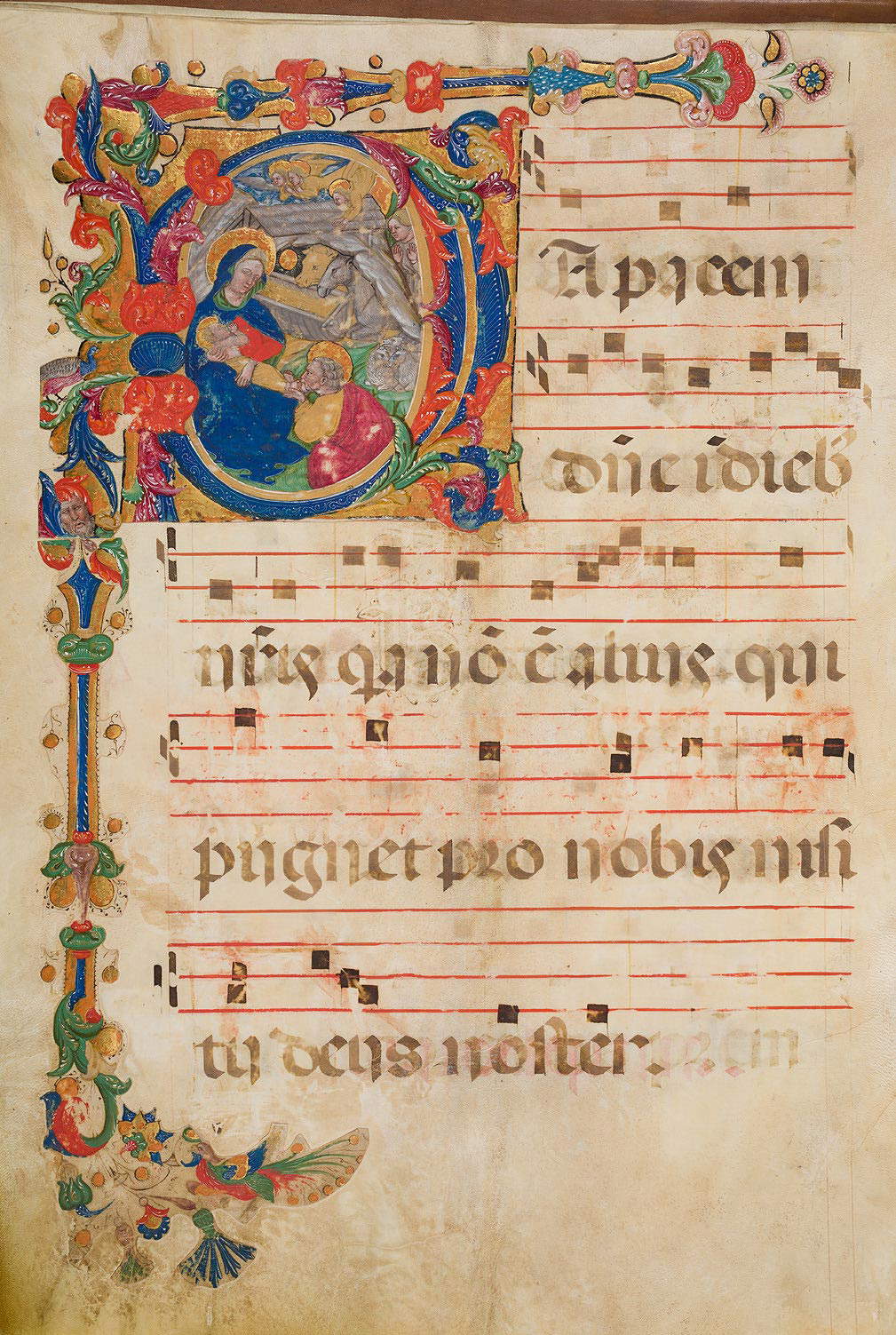
The Napoleonic occupation first and the laws that sanctioned the suppressions of the conventual orders later caused the dispersion of St. Justine’s library holdings, which began in part, however, very early on, since the monasteries of Barbo’s congregation were considered part of a single juridical body, so it was permissible for friars moving from one abbey to another to take their illuminated manuscripts with them. “It was an opportunity,” explains Francesco Trolese, “for the volumes that the transferred monks kept in their cells to emigrate from the monasteries along with the people, volumes that, however, remained described in the abbey inventory. For this reason there were frequent dispersions of books in the reformed monasteries.” So, because of these different historical events, the precious manuscripts once kept in the Padua monastery today enrich museums around the world, for example, the Victoria and Albert Museum in London or the Musée Marmottan Monet in Paris, where there are some fragments of illuminated manuscripts that were decorated by one of the greatest specialists of the 15th century, Girolamo da Cre mona (Cremona, first half of the 15th century - after 1483). However, a few codices have remained at Santa Giustina, in particular some choral books, large-format liturgical codices that contained the chants that were to be sung by the choir singers: the often enormous formats had precisely the function of making the texts easily readable to those who took their places in the choir.
These books date from the first half of the fifteenth century and are believed to have been made at the time when the abbot of Santa Giustina was Mauro Folperti da Pavia, successor to Ludovico Barbo, who ruled the fortunes of the monastery from 1437 to 1457, with brief periods of intermittency. The oldest material is contained in Chorale 1, where there are initials pasted from antiphonaries and graduals that have been lost and were made around 1440 by Cristoforo Cortese (Venice, c. 1399 - 1445), one of the leading Venetian illuminators of the first half of the 15th century. His initials, Toniolo pointed out in her study devoted to the liturgical miniatures of the Paduan abbey, are characterized by richness of the painting, softness of the ornamentation detected in white lead, and intense physiognomic characterization of the sacred characters, which “well indicate how the patron had chosen the right artist.” Cortese, the scholar explains, “is capable of giving the images intense pathetic force conjoined with great imagination, apt at visual involvement, capable not only of making it easier to memorize the chant but also of aiding contemplation of the word. Folperti’s choice in favor of Cristoforo turns out to be significantly in tune with that of the monks of the Abbey of San Giorgio in Venice, co-founders of the Congregazione de unitate, where a Psalter marked N by Cortese’s hand is still preserved, clearly coeval in style to the Paduan proofs. It is also evident how the patron must not have skimped on expenses because of the extensive use of gold foils, moreover skillfully engraved and worked, and of varied and luminous colors. In the few remaining friezes pasted on Chorale 1 appear passages of great naturalism with flowers and animals.”
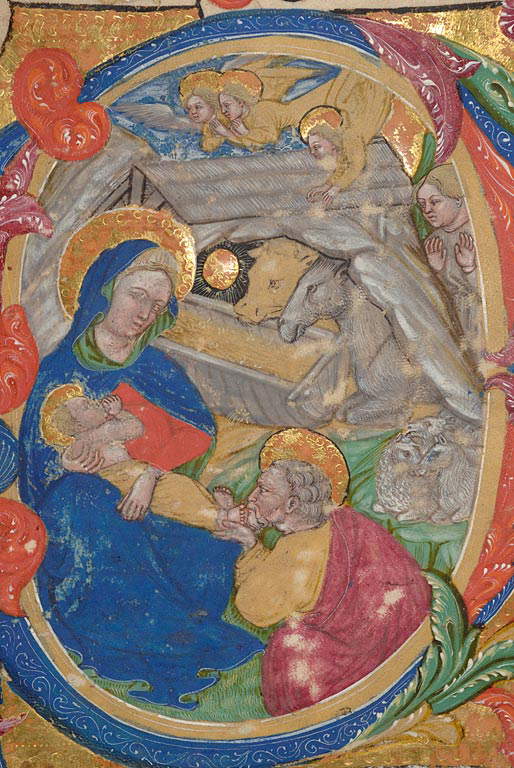
 Cristoforo Cortese, Initial
Cristoforo Cortese, Initial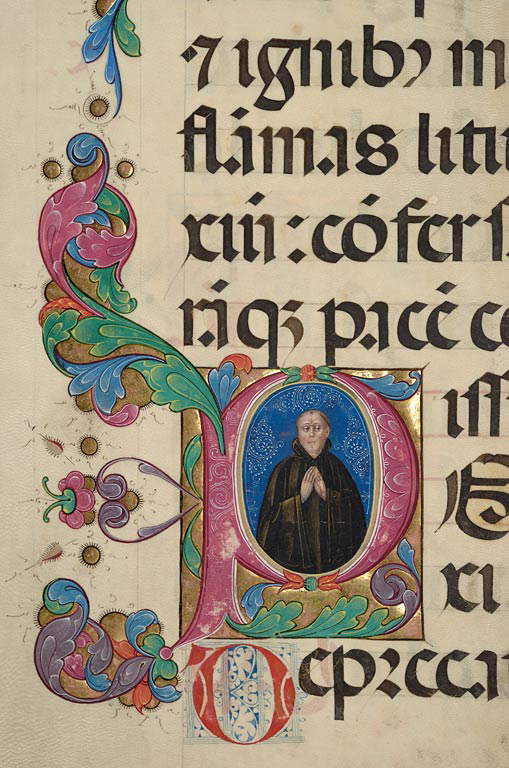 Cristoforo Cortese, Particular
Cristoforo Cortese, Particular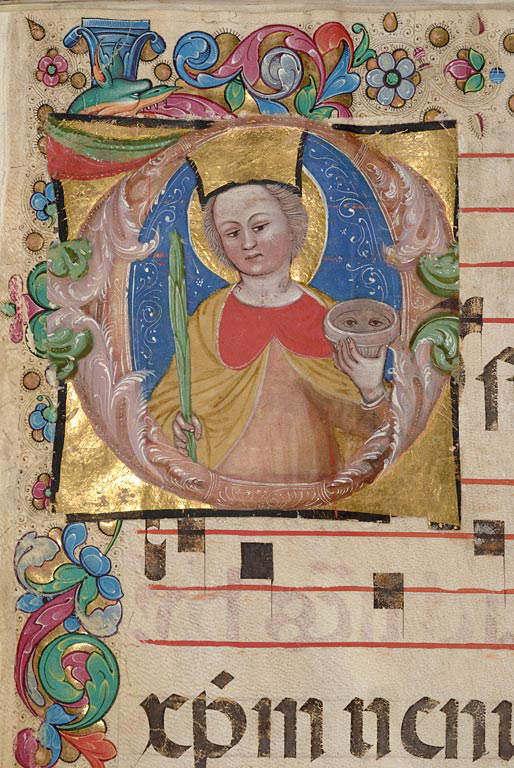 Cristoforo Cortese, Particular
Cristoforo Cortese, ParticularAn essay of the refinement of Cortese’s art, as well as its originality, can be had by admiring an “O” historiated with the image of a Nativity that actually merges two iconographic traditions, on the one hand that of the Nativity, and on the other that of Our Lady of Milk, since one notices the Virgin caught breastfeeding the Child, with another curious detail, that of St. Joseph caressing and kissing his son’s little feet. In the small space of an initial, Cortese thus succeeds in creating a lively image that stands out for its distinct narrative taste, further underscored by the character on the right raising his hands in amazement before the sacred scene.
Also preserved in the Paduan abbey is a precious testimony by Girolamo da Cremona for Santa Giustina: this is Chorale 2, which features capilettera with elegant architectural letters, that is, letters imitating architecture, one of which also contains a portrait of the prophet Job, who finds space within an “N” whose legs become two columns (we do not know, however, whether the figure of the prophet is the work of Girolamo or one of his collaborators). According to Toniolo, these works were made by Girolamo da Cremona after seeing Mantegna’s works in Padua: one perceives a debt to the Renaissance architecture that characterized especially the scenes in the Ovetari Chapel, and in addition, even Jacob’s robe, characterized by the same harsh and sculptural sign typical of Mantegna’s draperies, recalls precise Mantegna precedents (such as Saint Julian of the Polyptych of Saint Luke). Girolamo da Cremona was among Mantegna’s collaborators and was responsible for the renewal of the art of miniature painting in Padua: his style, according to Federica Toniolo, is also indebted to Borso d’Este’s enterprise of the Bible, as well as to Mantegna, from whom he derives the "ability to insert scenes perspective within architectural initials, real painted sculptures, creating, compared to the late Gothic proofs and in full harmony with the dictates of the devotio moderna, a new involvement of the spectator." An involvement of the viewer possible thanks to the effects of illusionism that Girolamo had learned from Mantegna himself.
The renewal of the miniature that started from the Abbey of St. Justine led to results that were destined to last: soon the innovations elaborated in Padua spread to the other centers of the congregation, which looked to St. Justine in their choice of subjects and decorative motifs. And of course, there were not only chorals: the scriptorium of St. Justine, in the fifteenth century, was particularly active in the production of books that served for the celebration of liturgies, from antiphonaries to missals, from breviaries to lectionaries and hymnals. In the monastic library, however, one could find not only works of a sacred character, but works from Greek and Latin classicism, albeit to a lesser extent. And the Paduan miniature tradition did not cease in the fifteenth century: in the following century, important illuminators such as Antonio Maria da Villafora (whose miniatures can be found in Chorale 1, following the fifteenth-century part), Benedetto Bordon, and Girolamo dai Libri took turns. It is a sign that art continued to be a fundamental element in the daily activities of the monks of Santa Giustina for a long time as well.
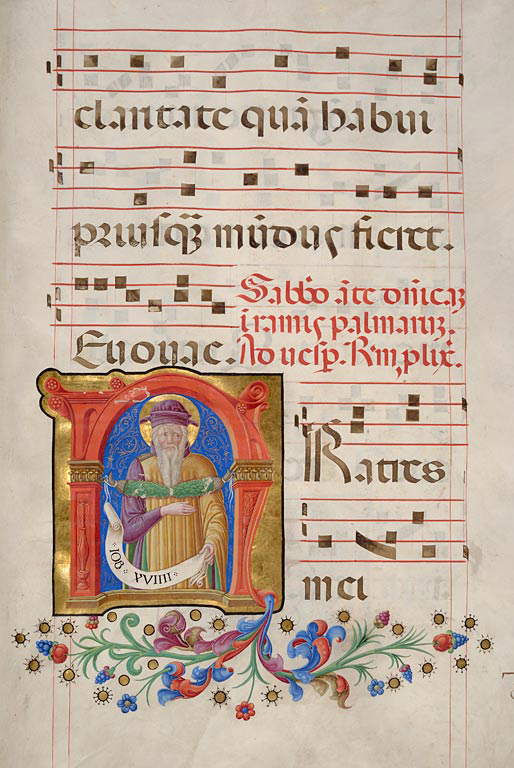

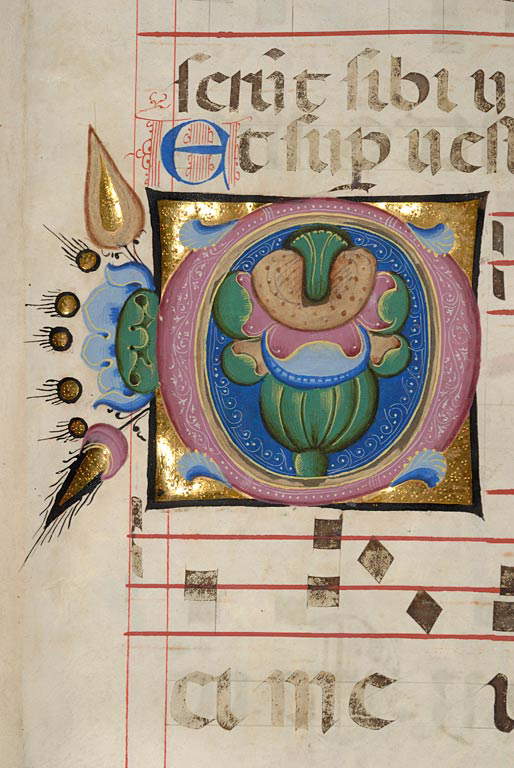
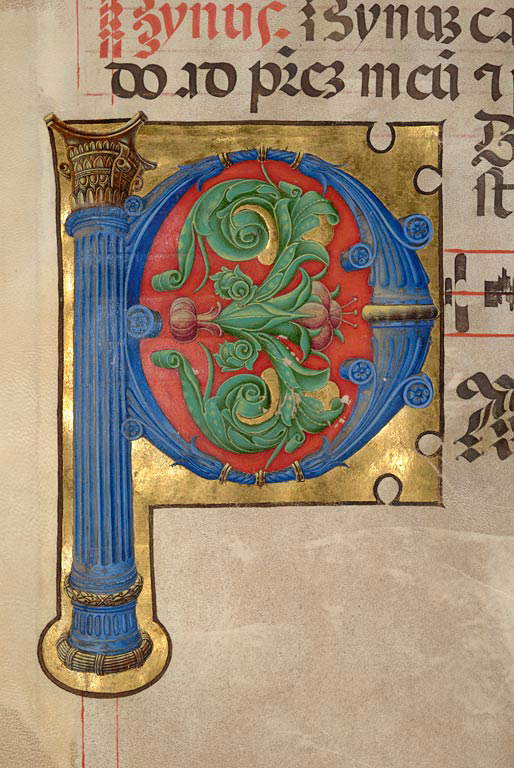
The Benedictine Abbey of Santa Giustina is located beside the Prato della Valle in the center of Padua and arose alongside the basilica founded in the 5th century over the tomb of St. Justina, a Paduan virgin and martyr. From the Abbey of St. Justina, in the 15th century, when Ludovico Barbo was abbot, began the reform that gave rise to the Congregation of St. Justina, since 1505 called the “Cassinese Congregation.” The Monastery, equipped with as many as five cloisters, was suppressed by Napoleon in 1810 and turned into a barracks. Reopened in 1919, since the end of World War II it has become the site of cultural institutes, including the Institute of Pastoral Liturgy attached to the Pontifical Athenaeum of Sant’Anselmo in Rome, the Ancient Book Restoration Laboratory and the Library. The latter has existed since the first settlement of the monks in the 10th century, in keeping with the traditional love of culture inspired by St. Benedict.
In the 15th century, the Library was enriched with numerous preciously illuminated choir books: in 1493 there were as many as 1,337, kept in the Old Library, the present “St. Luke’s Hall.” The holdings increased considerably after relations between the library and the University of Padua tightened to the point that a new location was needed; thus a large room, thirty by ten meters, was built, furnished with shelving by the Flemish architect Michele Bartems. At the time of the Napoleonic suppression (1810) the holdings were rich with 80,000 volumes, which were dispersed to various locations. Books from Santa Giustina enriched the Braidense Library in Milan, the Marciana in Venice, the Civic Museum and the University Library in Padua, and other volumes flowed onto the antiquities market and can be found scattered all over the world: from Paris to London, from New York to Los Angeles, from Cape Town to Berlin and Budapest. With the reopening of the abbey in 1919, the new monks returned to increase the library’s holdings, which now number 140,000 volumes: the Library specializes in religious sciences (Bible, patristics, theology, liturgy) and history (monastic, ecclesiastical and local), but other disciplines, such as philosophy and Italian and classical literature and art history, are also present in its holdings. It also has 1,300 periodicals, 500 of which are current. Established in 1943 as a library exclusively serving the Benedictine monastic community of Santa Giustina, since 1972 it has been a state public library, open for consultation to every Italian citizen (and by extension to every citizen of the European Union), and a peripheral institute of the Ministry of Culture.

Warning: the translation into English of the original Italian article was created using automatic tools. We undertake to review all articles, but we do not guarantee the total absence of inaccuracies in the translation due to the program. You can find the original by clicking on the ITA button. If you find any mistake,please contact us.